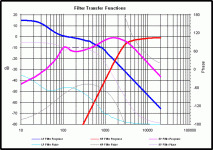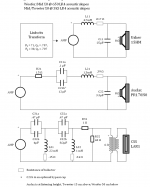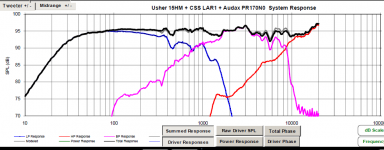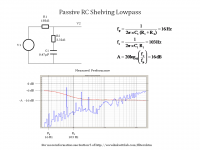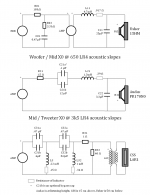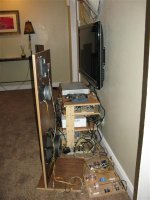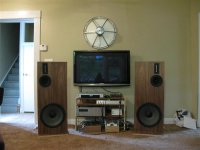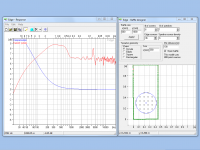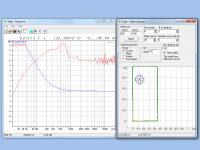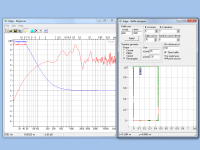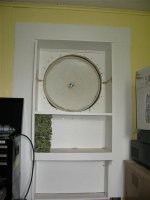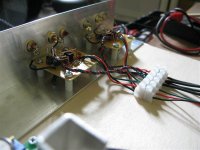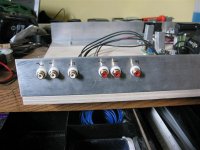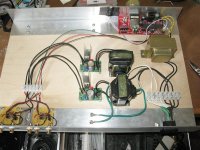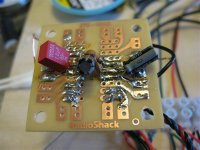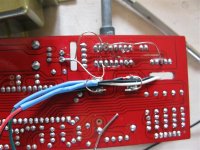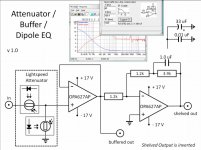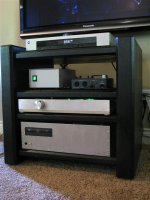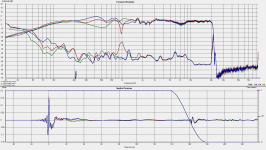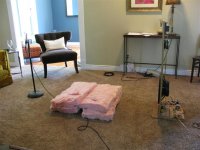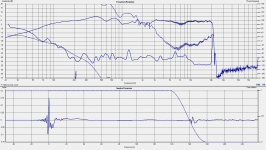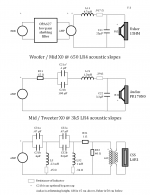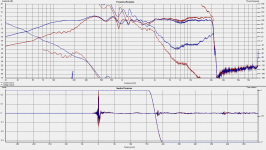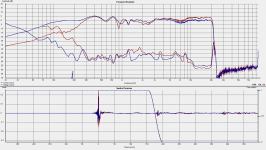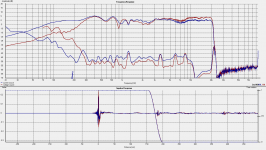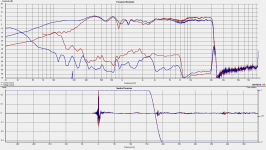I also came up with a simpler passive XO which I could implement with components I had on hand. It crosses the Audax to the ribbon at 8k with a .5 mH inductor in series with the Audax, and a 2 uF metal foil cap on the ribbon. The woofers are still crossed digitally with LR2 at 450 (which actually ends up crossing the woofer to the mid at 700 Hz). The summed response is below and as you can see reasonably flat for its simplicity. Compared to the digital Xo at 3.5 some of the detail is missing and distortion is noticeably higher at higher volumes, but the Audax does a remarkable job in this setup. This setup does have the potential to cause ribbon destruction. If you look closely you'll notice the LAR1 is actually more attenuated with the LR4 crossover at 3.5k compared to the 1st order at 8k.
Attachments
Any update to this project? I'm about to start a similar build with the Usher 15hm, the B&C 8pe21, and Altec 802s on Azura 550 horns.
thanks,
Mordikai
thanks,
Mordikai
Hi mordikai,
Sounds like an interesting project.
Since I last posted I have built the crossovers depicted in post 22. I have also assembled a regulated gainclone (using AudioSector boards) which I am using to power the Ushers, and one of Mark Houston's Zero Component Amplifiers (ZCA, DIY Class-A 2SK1058 MOSFET Amplifier Project) which I am using to power the mid and the ribbon. I much prefer the mid/treble of the ZCA to the gainclone, but the gainclone does a great job of controlling the Ushers.
I have also replaced the active bass boost with a passive shelving filter. The filter cuts the line signal by about 10db and provides about 10db of bass boost. Both amplifiers are now feed by an EMU 0404 USB DAC.
Sounds like an interesting project.
Since I last posted I have built the crossovers depicted in post 22. I have also assembled a regulated gainclone (using AudioSector boards) which I am using to power the Ushers, and one of Mark Houston's Zero Component Amplifiers (ZCA, DIY Class-A 2SK1058 MOSFET Amplifier Project) which I am using to power the mid and the ribbon. I much prefer the mid/treble of the ZCA to the gainclone, but the gainclone does a great job of controlling the Ushers.
I have also replaced the active bass boost with a passive shelving filter. The filter cuts the line signal by about 10db and provides about 10db of bass boost. Both amplifiers are now feed by an EMU 0404 USB DAC.
My wife and I will be moving into a house with a much larger living room (15' x 17' x 9') in May. I'm planning on going full open baffle once we take residence. I'll shift the shelving filter up an octave or so to compensate for baffle step loss and then add a monopole sub to fill in the bottom end. I have already purchased an O-audio 500 watt BASH plate amp and a Dayton RSS315HF-4.
I've finally moved and had sometime to play with some audio stuff.
I obtained a 24" Hartley subwoofer from a nice gentleman in Boise Idaho. I'm powering the Hartley with a 500 watt o-audio plate amp. The plate amp is way overkill but the bass eq, parametric eq, and low pass is handy. The Hartley handles musical bass with authority. It can make some odd noises when pushed too hard with theatrical explosions and such. I have the high pass on the plate set to 25Hz which keeps the Hartley happier.
My new baffles are 18" wide by 45" tall. The size and shape is based on domestic and SAF constraints, but the driver placements have been optimized with edge to reduce ripple in their respective bandwidths. The baffles are comprised of 13 layer .75 inch Baltic Birch with walnut veneer front and back.
I've also put together a remote controlled lightspeed attenuator + OPA627 buffer + OPA627 dipole eq which I still need to document. The dipole eq brings the bass extension to 80Hz were the Hartley takes over. There is currently no dipole peak equalization. The modeled peak is fairly low q and only about 2 db in amplitude. Measurements show it to be pretty tame as well.
I still need to build boxes for the crossovers and get a better av rack. Right now it is quite the eyesore.
I obtained a 24" Hartley subwoofer from a nice gentleman in Boise Idaho. I'm powering the Hartley with a 500 watt o-audio plate amp. The plate amp is way overkill but the bass eq, parametric eq, and low pass is handy. The Hartley handles musical bass with authority. It can make some odd noises when pushed too hard with theatrical explosions and such. I have the high pass on the plate set to 25Hz which keeps the Hartley happier.
My new baffles are 18" wide by 45" tall. The size and shape is based on domestic and SAF constraints, but the driver placements have been optimized with edge to reduce ripple in their respective bandwidths. The baffles are comprised of 13 layer .75 inch Baltic Birch with walnut veneer front and back.
I've also put together a remote controlled lightspeed attenuator + OPA627 buffer + OPA627 dipole eq which I still need to document. The dipole eq brings the bass extension to 80Hz were the Hartley takes over. There is currently no dipole peak equalization. The modeled peak is fairly low q and only about 2 db in amplitude. Measurements show it to be pretty tame as well.
I still need to build boxes for the crossovers and get a better av rack. Right now it is quite the eyesore.
Attachments
Here is the back side of the Hartley. It is firing into my office. At one point in time there was a doorway which was closed and turned into some shelves. The wall is 1/2 drywall + 1" planks + 0.5" plywood. I basically ripped out one shelf and cut a big hole. The screws on this side are to keep plywood from resonating.
Attachments
Here is my remote controlled lightspeed attenuator with dipole eq. The remote controlled part is via a modified diyclub.biz MV-02. The OPA627 opamps are powered by tangentsoft.net TREAD regulators.
The buffer and shelving eq are stacked on the pcb. I don't think I would have gone this route if I had it to do over again. It makes it rather difficult to make modifications. On the plus side it keeps the signal paths pretty short.
The buffer and shelving eq are stacked on the pcb. I don't think I would have gone this route if I had it to do over again. It makes it rather difficult to make modifications. On the plus side it keeps the signal paths pretty short.
Attachments
New av rack
I finally got around to building a proper AV rack. It weighs around 140 pounds and was not fun to move around but it does dress up the setup a bit.
The shelves are fixed and the whole this is comprised of MDF. The shelves are 1.5 inches thick and the sides are a full 3 inches think. My amps now reside in my office directly behind the rack.
I finally got around to building a proper AV rack. It weighs around 140 pounds and was not fun to move around but it does dress up the setup a bit.
The shelves are fixed and the whole this is comprised of MDF. The shelves are 1.5 inches thick and the sides are a full 3 inches think. My amps now reside in my office directly behind the rack.
Attachments
Crossover tweaking
Over the pass month or so I have also been tweaking with my crossover. I still wouldn't call it done, but I think it is getting better. The green trace below shows the measured frequency response with the original crossover. The dip at ~1kHz is a result of the mid high-pass and the baffle. The red trace shows the original crossover scheme with polarity reversed on the Usher. The blue trace shows the frequency response with the revised crossover. The solid lower traces show THD as calculated by HOLM Impulse. The revised crossover is more gritty in the mid bass (in a good way).
Over the pass month or so I have also been tweaking with my crossover. I still wouldn't call it done, but I think it is getting better. The green trace below shows the measured frequency response with the original crossover. The dip at ~1kHz is a result of the mid high-pass and the baffle. The red trace shows the original crossover scheme with polarity reversed on the Usher. The blue trace shows the frequency response with the revised crossover. The solid lower traces show THD as calculated by HOLM Impulse. The revised crossover is more gritty in the mid bass (in a good way).
Attachments
Last edited:
Measurement details
All measurements were made with HOLM Impulse. Mic use a ecm8000 with a generic calibration file. The sound card was an EMU 0404-usb with the ADC-DAC calibration at 192kHz. The speaker was about 1 meter from the rear wall and the mic was on axis about 2 meters from the speaker. Initial measurements showed the floor reflection at 80 cm (first attachment). I was able to mostly remove it with 6 inches of fiberglass insulation placed between the mic and the speaker (second attachment). The reflection off the rear wall is the blirp past 160 cm in the impulse plots.
All measurements were made with HOLM Impulse. Mic use a ecm8000 with a generic calibration file. The sound card was an EMU 0404-usb with the ADC-DAC calibration at 192kHz. The speaker was about 1 meter from the rear wall and the mic was on axis about 2 meters from the speaker. Initial measurements showed the floor reflection at 80 cm (first attachment). I was able to mostly remove it with 6 inches of fiberglass insulation placed between the mic and the speaker (second attachment). The reflection off the rear wall is the blirp past 160 cm in the impulse plots.
Attachments
Revised crossover details
Basically the only differences are that the polarity on the woofers gets swapped and the 12uF high pass cap on the mid gets swapped out for a 100uF cap. A 70 uF cap would be more ideal but I actually had some 100uF Dayton Poly caps on hand.
EDIT: The broad peaks at ~400 and ~800 Hz are caused by the baffle. These peaks are predicted by Edge (see post 30). I am contemplating implementing a passive notch filter but I need to figure out how to calculate it for a current source. I simulated a textbook parallel notch filter with LTSpice and it didn't behave as well as it could have with a current source.
Basically the only differences are that the polarity on the woofers gets swapped and the 12uF high pass cap on the mid gets swapped out for a 100uF cap. A 70 uF cap would be more ideal but I actually had some 100uF Dayton Poly caps on hand.
EDIT: The broad peaks at ~400 and ~800 Hz are caused by the baffle. These peaks are predicted by Edge (see post 30). I am contemplating implementing a passive notch filter but I need to figure out how to calculate it for a current source. I simulated a textbook parallel notch filter with LTSpice and it didn't behave as well as it could have with a current source.
Attachments
Last edited:
Current Source vs. Voltage Source
The frequency responses above where all measured with my Mark Houston ZCA tranconductance amplifier. For the sake of curiosity I made some measurement comparisons with my TDA7265 chipamp. The bass rolloff is much more pronounced with the chipamp as expected. The ribbon is also up a couple dB with the chipamp.
To my surprise the chipamp and ZCA have about the same THD at 90 dB (second figure). I fully expected the distortion to be worse with the ZCA. As we can see from the third figure the ZCA has higher 2 order harmonic distortion. The fourth figure shows the chipamp has higher 3rd order distortion.
All and all I am becoming quite satisfied with the sound I'm getting from this setup.
The frequency responses above where all measured with my Mark Houston ZCA tranconductance amplifier. For the sake of curiosity I made some measurement comparisons with my TDA7265 chipamp. The bass rolloff is much more pronounced with the chipamp as expected. The ribbon is also up a couple dB with the chipamp.
To my surprise the chipamp and ZCA have about the same THD at 90 dB (second figure). I fully expected the distortion to be worse with the ZCA. As we can see from the third figure the ZCA has higher 2 order harmonic distortion. The fourth figure shows the chipamp has higher 3rd order distortion.
All and all I am becoming quite satisfied with the sound I'm getting from this setup.
Attachments
On one wants to comment on your OB, looks like it you take the time to document the design and to design them properly and with measurements as well. With a Raal tweeter I am sure it will sound quite good, the Audax midrange will sound smooth(I am told) and dynamic?. Question, have you measured the tweeter off axis, i found my ribbon tweeter(HI_VI brand) does not have good off axis performance what about yours?
My arrangement is similar to yours, TMWW, Tweeter is Hi-Vi, RT8II, Midwoofer is PHL 2460(very good but quite expensive), Twin woofers Eminence Acousinator 12". I mounted my woofers in a U-frame which will get them lower in frequency response, so very little shelving compensation is required.
Cheer, happy listening.
My arrangement is similar to yours, TMWW, Tweeter is Hi-Vi, RT8II, Midwoofer is PHL 2460(very good but quite expensive), Twin woofers Eminence Acousinator 12". I mounted my woofers in a U-frame which will get them lower in frequency response, so very little shelving compensation is required.
Cheer, happy listening.
All measurements were made with HOLM Impulse. Mic use a ecm8000 with a generic calibration file. The sound card was an EMU 0404-usb with the ADC-DAC calibration at 192kHz. The speaker was about 1 meter from the rear wall and the mic was on axis about 2 meters from the speaker. Initial measurements showed the floor reflection at 80 cm (first attachment). I was able to mostly remove it with 6 inches of fiberglass insulation placed between the mic and the speaker (second attachment). The reflection off the rear wall is the blirp past 160 cm in the impulse plots.
Hello Roger ,
I cannot see how your gated responses would be accurate below 2 K . I would
suggest installing the speaker on a table and measure @ 1 m for better results .
regards,
Hi ttan98,
Yes I think the Audax is quite dynamic and also quite clean. I have done throw away measurements of my ribbon and it does pretty good horizontally. Nothing to complain about IMHO. I've never measured the vertical but it seems to be fine whether I'm standing or sitting at 2.5m. I can't say the same for my NEO8s. They are noticeably limited in vertical dispersion. I'll try to get you some measurements next time I feel motivated to get the microphone out. The ribbon is actually a CSS LAR1. It is made by Aurum Cantus and it has a special honeycomb diaphragm that is suppose to reduce distortion. It is the big brother to the RT1.
Hi a.wayne,
I'm open to suggestions but would like more of a explanation before I go to the trouble of putting it up on a table. How do you get your 2k figure?
This speaker is pretty large it doesn't really integrate at 1 meter which is why I used the 2 meter distance. The 2 meter distance also helps with the proximity effect which leads to downward tilting frequency responses. John Atkinson in this article states:
The 2 meter distance is also closer than 1 meter to the listening distance which I think makes it more valid.
I think there is also rationale for keeping it on the floor because the woofer is in close to the floor and the reflection contributes to the low frequency response. If the speaker is placed on a table that contribution is negated.
I could see rationale for not believing the gated response below 500 Hz. In post 35 the floor reflection is clearly visible at 80 cm. When you view the impulse response in dB there is still clearly something at 80 cm after the fiberglass insulation is applied but I think the contribution is minimal. Lynn Olson and John Atkinson (and probably many others) use similar techniques to absorb the floor bounce. The rear wall reflection shows up at 160cm. (so the baffle was really closer to 80 cm from the rear wall). I have 9' 2" ceilings so the ceiling reflection should be at about 200 cm.
The last reason I have some confidence in the gatings as presented is that the peaks at 400Hz, and 800Hz coorespond exactly to where Edge predicts they should be (see post 30).
With kind regards,
Roger
Yes I think the Audax is quite dynamic and also quite clean. I have done throw away measurements of my ribbon and it does pretty good horizontally. Nothing to complain about IMHO. I've never measured the vertical but it seems to be fine whether I'm standing or sitting at 2.5m. I can't say the same for my NEO8s. They are noticeably limited in vertical dispersion. I'll try to get you some measurements next time I feel motivated to get the microphone out. The ribbon is actually a CSS LAR1. It is made by Aurum Cantus and it has a special honeycomb diaphragm that is suppose to reduce distortion. It is the big brother to the RT1.
Hi a.wayne,
I'm open to suggestions but would like more of a explanation before I go to the trouble of putting it up on a table. How do you get your 2k figure?
This speaker is pretty large it doesn't really integrate at 1 meter which is why I used the 2 meter distance. The 2 meter distance also helps with the proximity effect which leads to downward tilting frequency responses. John Atkinson in this article states:
Older engineers are probably used to measuring a speaker's frequency response at 1m. This, I feel, is too close for all but very small speakers (see later). I therefore use a standard microphone distance of 50" (1.27m), which is the farthest I can get back in my room and still preserve reasonable measurement bandwidth. Ideally, I would like to measure at 2m, where a large loudspeaker's drive-units will be better-integrated and where there will be less proximity effect (more on this later).
The 2 meter distance is also closer than 1 meter to the listening distance which I think makes it more valid.
I think there is also rationale for keeping it on the floor because the woofer is in close to the floor and the reflection contributes to the low frequency response. If the speaker is placed on a table that contribution is negated.
I could see rationale for not believing the gated response below 500 Hz. In post 35 the floor reflection is clearly visible at 80 cm. When you view the impulse response in dB there is still clearly something at 80 cm after the fiberglass insulation is applied but I think the contribution is minimal. Lynn Olson and John Atkinson (and probably many others) use similar techniques to absorb the floor bounce. The rear wall reflection shows up at 160cm. (so the baffle was really closer to 80 cm from the rear wall). I have 9' 2" ceilings so the ceiling reflection should be at about 200 cm.
The last reason I have some confidence in the gatings as presented is that the peaks at 400Hz, and 800Hz coorespond exactly to where Edge predicts they should be (see post 30).
With kind regards,
Roger
- Status
- Not open for further replies.
- Home
- Loudspeakers
- Multi-Way
- CSS LAR1 Ribbon, Audax PR170N0, Usher 15HM
